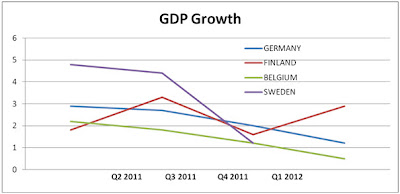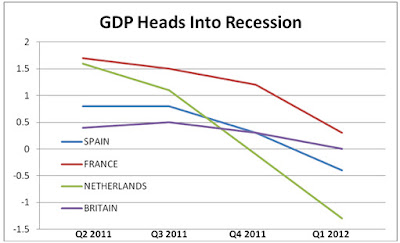Three Speeds In Europe, All SlowerBy Michael Burke
The latest publication of the GDP data for the EU shows three distinct trends but one unifying theme – slower growth.
In an important but dwindling group are those economies which are still expanding, led by Germany where GDP grew by 0.5% in the first quarter of 2012. In a larger group are those countries where the economy is stagnant. This now includes France which recorded zero growth in the quarter. The largest numerical group are those countries in recession, which includes Britain, Italy, Spain, Ireland, Portugal and Greece. The net result was that both the Euro Area group of 17 countries and the EU group of 26 recorded zero growth in the quarter.
If the focus shifts to the 12-month growth rates, comparing the first quarter of 2012 to the same quarter in 2011, the picture is even more stark. Outside of the Baltic States, which are still recovering from a 1930s-style Depression with the aid of substantial EU investment , only two countries recorded growth above 1.0%. These were Finland at 2.9% and Germany at 1.2%. The fact that the German motor of the EU economy is sputtering close to 1% growth is cause for alarm. It suggests that the entire EU economy is decelerating, and that the risk of renewed recession is increasing.
In fact this is the EU Commission’s forecast for 2012; a contraction of 0.3% for the Euro Area and zero growth in the EU as a whole. For the Euro Area 12-month growth is also now zero, and for the EU as a whole it is just 0.1%.
Even for the group of countries where growth has been strongest, growth is clearly slowing. The deceleration of the German economy is important for the entire European economy. These trends are shown in Figure 1.
T Walkerhttps://www.blogger.com/profile/11107827543023820698noreply@blogger.com0





Recent Comments